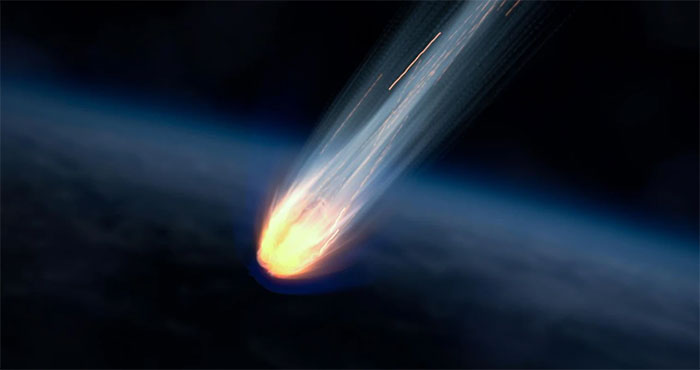New direction to search for alien life
If life can spread from one planet to another (that is, the theory of birth), Earth scientists have a chance of detecting alien life, according to a new study.
Astronomers are continuing their journey to find alien life. While the solar system currently has some promising locations, the sheer number of planets out there means humans are more likely to find life on planets orbiting other stars.

Simulate a meteorite rushing through the Earth's atmosphere. (Photo: JOHNS HOPKINS UNIVERSITY).
The US Space Agency (NASA) has so far found more than 5,000 confirmed planets, and the number continues to increase, according to Live Science .
However, efforts to find alien life are facing a major obstacle: astronomers don't know where to look. Humans only know of one type of planet that definitely has life, which is Earth. Therefore, the search mainly revolves around planets that have some similarities with Earth, although the possibility of finding them is very low.
Faced with the above situation, two astronomers named Harrison Smith (Tokyo Institute of Technology, Japan) and Lana Sinapayen (Sony Computer Science Laboratory, Japan), respectively, brought a new approach: reducing the focus on the possible forms of life, but rather on what life can do.
They came up with a strategy to find life based on the concept of the planet's birth theory , which means life could start on one planet and spread to other planets thanks to meteorites.
One of the key characteristics of any life is its ability to alter the natural balance of a planet.
Although it is unclear what changes alien life could make on a planet, if life has the ability to spread from one planet to another, it could seek to make similar changes. on every planet in his path.
In the new report, researcher Smith and his colleague Sinapayen put the test in a statistical manner. If humans collect the characteristics of enough planets, we can identify a cluster of nearby planets with similar characteristics.
The approach is expected to provide key clues that something strange is happening on planets, and the cause may be that life has spread between nearby stars.
- Alien life can be discovered in the next 20 years
- Stunned new alien life exploration tool
- Hunt for aliens by wavering
- Search for aliens by giant telescopes
- Course to search for aliens
- Alien life can be found in the next 30 years
- With this situation, even if we find aliens, we are not sure
- NASA plans to find alien life near Jupiter
- A billion dollars to find aliens
- Building light lighthouse in space to attract aliens
- American astronomer declares 'shock' about alien habitation
- Can artificial intelligence predict the probability of alien life?
 'Fine laughs' - Scary and painful torture in ancient times
'Fine laughs' - Scary and painful torture in ancient times The sequence of numbers 142857 of the Egyptian pyramids is known as the strangest number in the world - Why?
The sequence of numbers 142857 of the Egyptian pyramids is known as the strangest number in the world - Why? History of the iron
History of the iron What is alum?
What is alum? Robinson in real life: Living alone in the wild for 30 years before passing away at the age of 83
Robinson in real life: Living alone in the wild for 30 years before passing away at the age of 83  Habitable planet appeared next to Earth, but met with disaster
Habitable planet appeared next to Earth, but met with disaster  Top 7 lifestyles that explain why Nordic people are considered the happiest in the world
Top 7 lifestyles that explain why Nordic people are considered the happiest in the world  New signs of advanced alien life discovered
New signs of advanced alien life discovered  Tonight 'The paradoxical Earth' has life appearing, how to observe?
Tonight 'The paradoxical Earth' has life appearing, how to observe?  Experiment from America: Unexpected things about alien creatures
Experiment from America: Unexpected things about alien creatures 